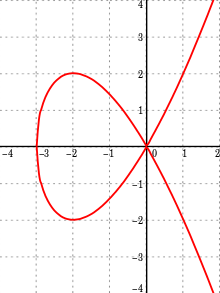Tschirnhausen cubic

The Tschirnhausen cubic, 

In geometry, the Tschirnhausen cubic, or Tschirnhaus' cubic is a plane curve defined by the polar equation
History
The curve was studied by von Tschirnhaus, de L'Hôpital, and Catalan. It was given the name Tschirnhausen cubic in a 1900 paper by R C Archibald, though it is sometimes known as de L'Hôpital's cubic or the trisectrix of Catalan.
Other equations
Put  . Then applying triple-angle formulas gives
. Then applying triple-angle formulas gives
giving a parametric form for the curve. The parameter t can be eliminated easily giving the Cartesian equation
 .
.
If the curve is translated horizontally by 8a then the equations become
or
 .
.
This gives an alternate polar form of
 .
.
References
- J. D. Lawrence, A Catalog of Special Plane Curves. New York: Dover, 1972, pp. 87-90.
External links
- Weisstein, Eric W., "Tschirnhausen Cubic", MathWorld.
- "Tschirnhaus' Cubic" at MacTutor History of Mathematics Archive
- "Cubique de Tschirnhausen" at Encyclopédie des Formes Mathématiques Remarquables (in French)
This article is issued from Wikipedia - version of the Monday, December 01, 2014. The text is available under the Creative Commons Attribution/Share Alike but additional terms may apply for the media files.






